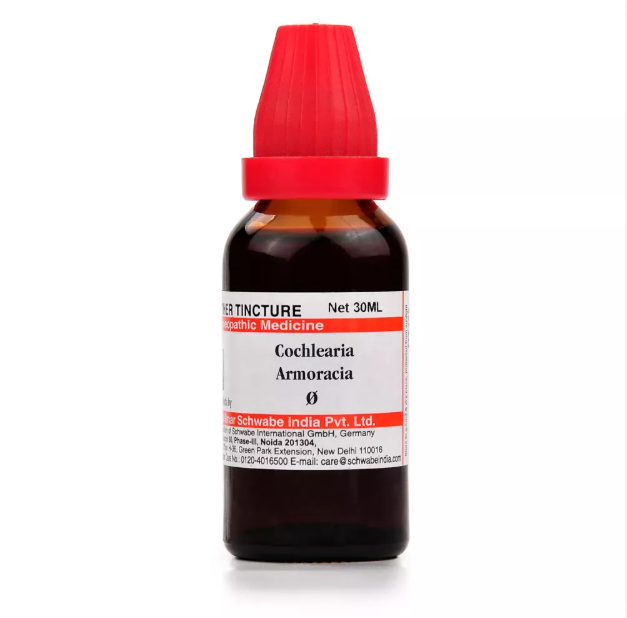COCHLEARIA ARMORACIA- ARMORACIA SATIVA Q, 6C, 12C, 30C, 200C, 1M, 10M USES AND SYMPTOMS
 Cochlearia Armoracia – Armoracia Sativa
Cochlearia Armoracia – Armoracia Sativa
Coch.
This drug specifically affects the frontal bone and sinus, antrum, and salivary glands. It causes a bloated sensation and raises the vital force. Used as a gargle for scorbutic gums and sore throat, it helps with hoarseness and relaxed conditions of the fauces. Internally, it is used for gonorrhea and as a condiment for weak stomachs. An infusion of the root in cider causes copious diuresis and treats dropsy. Locally, it cures dandruff.
Head: Difficulty thinking, anxiety, despair from pain. Pressing, boring pain in the frontal bone. Violent headache with vomiting (migraine), impaired hearing.
Eyes: Sore, scrofulous, traumatic inflammation, blearedness, cataract. Copious lachrymation (conjunctivitis).
Stomach: Pain towards the back, worse with pressure on dorsal vertebrae. Belching, cramps, colic with backache. Violent cramps radiate from the stomach to the back. Griping around the navel.
Urinary: Burning and cutting pain in the glans penis before, during, and after urination. Frequent urination.
Respiratory: Dry, hacking laryngeal cough, post-influenzal cough (dry or loose), worse lying down. Chest painful to touch, coryza with hoarseness. Mucoid asthma, lung edema. Throat feels rough and hoarse.
Back: Pain from incarcerated flatus, radiates from the abdomen to the back and sacrum.
Modalities: Worse in the evening and at night.
Relationship: Compare with Cann-s., Sin-n., Caps.

SYMPTOMS OF COCHLEARIA ARMORACIA- ARMORACIA SATIVA
Head:
Difficulty thinking
Anxiety, despair from pain
Pressing, boring pain in the frontal bone
Violent headache with vomiting (migraine)
Impaired hearing
Eyes:
Sore, scrofulous
Traumatic inflammation
Blearedness, cataract
Copious lachrymation (conjunctivitis)
Stomach:
Pain towards the back, worsened by pressure on dorsal vertebrae
Belching, cramps
Colic with backache
Violent cramps radiating from the stomach to the back
Griping around the navel
Urinary:
Burning and cutting pain in the glans penis before, during, and after urination
Frequent urination
Respiratory:
Dry, hacking laryngeal cough
Post-influenzal cough (dry or loose), worse lying down
Chest painful to touch
Coryza with hoarseness
Mucoid asthma
Lung edema
Throat feels rough and hoarse
Back:
Pain from incarcerated flatus
Pain radiates from the abdomen to the back and sacrum
Modalities:
Symptoms worse in the evening and at night
selection of the potency
Individualization:
- Homeopathy is based on the principle of treating the individual, not just the disease. The unique symptoms and characteristics of the person are crucial in determining the most suitable potency.
Intensity of Symptoms:
- The intensity of the symptoms guides the choice of potency. If the symptoms are intense and acute, a lower potency (e.g., 6C, 30C) might be considered. For chronic conditions with less intensity, higher potencies (e.g., 200C, 1M) may be appropriate.
Sensitivity of the Patient:
- Some individuals are more sensitive to homeopathic remedies, while others may require higher potencies. The practitioner considers the patient’s sensitivity when selecting the potency.
Acute vs. Chronic Conditions:
- Lower potencies are often used for acute conditions, while higher potencies may be considered for chronic or long-standing issues.
Previous Response to Potencies:
- The patient’s response to previous homeopathic treatments helps guide the choice of potency. If a particular potency has been effective in the past, it may be repeated or adjusted as needed.
Vital Force and Susceptibility:
- Homeopathy views illness as a disturbance in the vital force. The practitioner assesses the patient’s overall vitality and susceptibility to determine the appropriate potency.
Aggravation or Amelioration:
- The direction of the symptom response (aggravation or amelioration) after taking a remedy can influence the choice of potency.
Miasmatic Considerations:
- In classical homeopathy, the concept of miasms (inherited disease tendencies) is considered. The practitioner take this into account when selecting the potency.
Practitioner Experience:
- The experience and preference of the homeopathic practitioner play a role. Some practitioners may have success with certain potencies based on their clinical experience.
SAFETY INFORMATION
- Do not exceed the recommended dose by physician
- Keep out of the reach of children
- Store in a cool dry place away from direct sunlight
- Maintain half an hour gap between food/drink/any other medicines and homoeopathic medicine
- Avoid any strong smell in the mouth while taking medicine e.g. camphor, garlic, onion, coffee, hing
Medicine images use for reference only selection of homeopathic medicine depends on the individual’s specific symptoms and overall constitution. Moreover, homeopathy is a holistic system of medicine that treats the individual as a whole. In addition to addressing the physical symptoms, it takes into account the emotional and mental state of the person. Consequently, it’s crucial to consult with a qualified homeopathic practitioner for personalized treatment.
The information provided on this website is intended solely for educational purposes. Always seek the advice of your physician or other qualified health provider.
